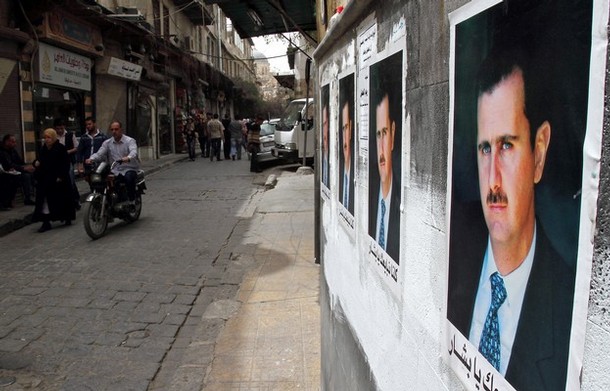Syria 1st-Hand: Observations from Damascus "The Subtle Signs of Turmoil"
 Wednesday, December 14, 2011 at 9:34 |
Wednesday, December 14, 2011 at 9:34 |  Scott Lucas in
Scott Lucas in  EA Middle East and Turkey,
EA Middle East and Turkey,  Middle East and Iran
Middle East and Iran  A young writer, his name withheld for the sake of security, reports for The New York Times:
A young writer, his name withheld for the sake of security, reports for The New York Times:
Observers often comment that the Syrian uprising has not reached Damascus. It is true that businesses and restaurants are open in central Damascus, that the traffic is as messy and congested as ever, that fashionable shopping malls bustle in the early evening with well-coiffed teenagers who descend from chauffeured luxury cars.
Unlike Homs, or Deir Ezzor, or Deraa, there are no tanks in the streets of Damascus, not even the ones painted patchy blue in a flimsy attempt to disguise the army as police. But the myth of Damascus’ sustained invincibility is just that – a myth. The signs of turmoil in the Syrian capital may be subtle, but they are nonetheless alarming.
Few people live in central Damascus anymore. The privileged elite maintain mansions in the center of the city, and commercial life is clustered there, but the majority of the population has drifted to the more affordable outlying neighborhoods, like Zahira and Midan, and the ever-expanding working-class suburbs that hastily consume the former farmland encircling the city.
Of this greater Damascus, the inhabited, residential, teeming, swelling Damascus of the masses, Muadhamiya, Kisweh, Deraya, Harasta, Zahira, Hajar al Aswad, Kafr Suseh, Midan, Sbeina, and Qaboun – among plenty of other neighborhoods – have all participated in the uprising. Friday protests, persistent civil disobedience, and vandalism of government property are commonplace.
And a price has been paid, from curfews and raids, to the recent beating of Ali Ferzat, a well-known political cartoonist. Mr. Ferzat was grabbed off the street in central Damascus–from the same square that is home to the Ministry of Defense, the Armed Forces headquarters, and the state television building—severely beaten, then thrown from a car. “That was the last picture you’ll ever draw,” his assailants told him as they broke his hands, referring to his recent illustration of Syrian president Bashar al Assad trying to thumb a ride with fleeing former Libyan leader Muammar el-Qaddafi.
There are other, more quiet signs of disruption and discontent, too. All the lights are turned down, nearly off, in the first floor of the grand and modern Four Seasons Hotel Damascus, long devoid of guests. The graffiti scrawled along the walls of Deraya demanding the downfall of the president has not been painted over (other walls must be blackened daily to smother the reoccurring messages of dissent).
There are daily electricity cuts, even in Malki, an expensive, central district, and the prices of basic food items are rising. Shortages of cooking gas have led to hoarding and price gouging and the line for heating fuel can be eight hours long. The growing economic hardships are exacerbated by the rapidly plummeting value of the Syrian lira, which has lost 25% of its value since March.
But compared to the northern, central, eastern, and southern cities under siege, Damascus seems calm, even stable. A recent United Nations report described a systematic policy in Syria of arbitrary detentions, torture, rape, and executions of adults and children. It also reported that in Homs, security officers disguised as doctors have patrolled the hospitals to arrest or kill the wounded. And when Ferzat Jarban, a Syrian cameraman, was arrested recently for filming anti-government protests, the next day he was found dead, with his eyes gouged out.
Damascus is shaken, but the city remains isolated from the worst. There has been no Tahrir Square here. There couldn’t have been, with the army stationed strategically in Abaseen Square and busloads of men brandishing clubs around Merjeh Square. But revolutions don’t always look the same.
In the context of the capital’s relative isolation – exacerbated by severed communications in besieged cities, extremely limited media access, and a vigorous government propaganda campaign – many Damascenes exhibit a gauzy but aggressive optimism about the conflict. Just about everyone I talk to here, in and around Damascus and its suburbs, tells me that the uprising – or the revolution, or the “events,” depending on political sympathies – is nearly over. The estimates range from two weeks to two months to an unspecified date just beyond the horizon, but there is a near desperate, delusionally hopeful agreement, despite widely divergent political views, that the end must be in sight.
 Ali Ferzat,
Ali Ferzat,  Bashar al-Assad,
Bashar al-Assad,  Damascus,
Damascus,  Ferzat Jarban,
Ferzat Jarban,  Muammar Qaddafi,
Muammar Qaddafi,  Syria
Syria 
Reader Comments